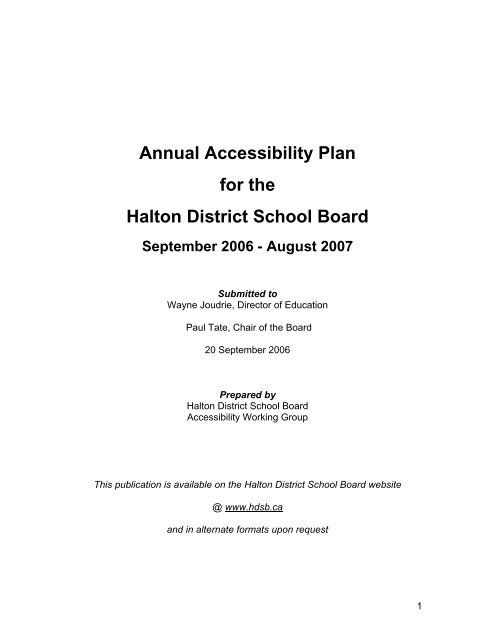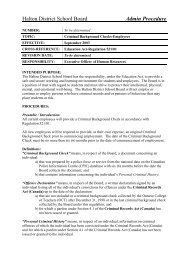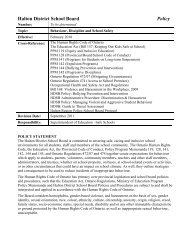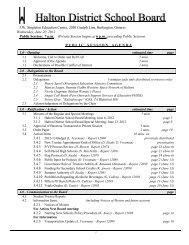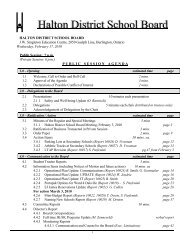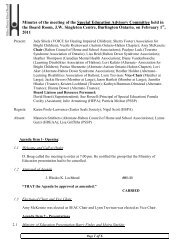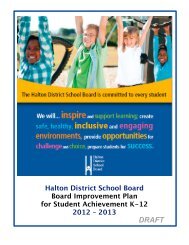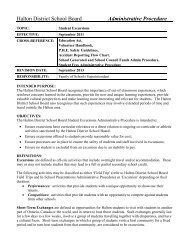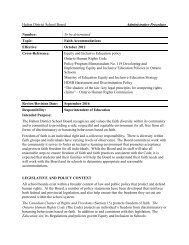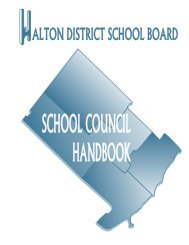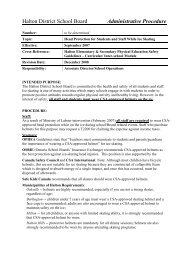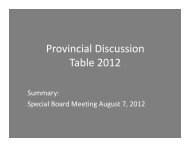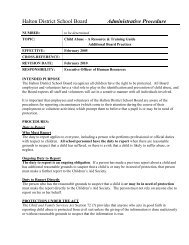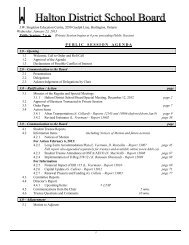2006-2007 Accessibility Plan - Halton District School Board
2006-2007 Accessibility Plan - Halton District School Board
2006-2007 Accessibility Plan - Halton District School Board
Create successful ePaper yourself
Turn your PDF publications into a flip-book with our unique Google optimized e-Paper software.
Annual <strong>Accessibility</strong> <strong>Plan</strong><br />
for the<br />
<strong>Halton</strong> <strong>District</strong> <strong>School</strong> <strong>Board</strong><br />
September <strong>2006</strong> - August <strong>2007</strong><br />
Submitted to<br />
Wayne Joudrie, Director of Education<br />
Paul Tate, Chair of the <strong>Board</strong><br />
20 September <strong>2006</strong><br />
Prepared by<br />
<strong>Halton</strong> <strong>District</strong> <strong>School</strong> <strong>Board</strong><br />
<strong>Accessibility</strong> Working Group<br />
This publication is available on the <strong>Halton</strong> <strong>District</strong> <strong>School</strong> <strong>Board</strong> website<br />
@ www.hdsb.ca<br />
and in alternate formats upon request<br />
1
<strong>Halton</strong> <strong>District</strong> <strong>School</strong> <strong>Accessibility</strong> <strong>Plan</strong> <strong>2006</strong>-<strong>2007</strong><br />
Table of Contents<br />
Page<br />
EXECUTIVE SUMMARY<br />
3<br />
1. Aim 4<br />
2. Objectives 4<br />
3. Commitment to accessibility planning 4<br />
4. Description of the <strong>Halton</strong> <strong>District</strong> <strong>School</strong> <strong>Board</strong> 5<br />
5. The <strong>Accessibility</strong> Working Group Members 6<br />
6. Barrier-removal initiatives during 2005-<strong>2006</strong> 7<br />
7. Measures in Place: Preventing new barriers 9<br />
8. Barrier-identification methodologies 10<br />
9. Barriers that will be addressed <strong>2006</strong>-<strong>2007</strong> 10<br />
10. Review and monitoring process 14<br />
11. Communication of the plan 14<br />
Appendix A: <strong>School</strong> <strong>Accessibility</strong>, June <strong>2006</strong> 15<br />
Appendix B: Suggested Reference/Resource Materials 19<br />
Appendix C: About Disability – the disability continuum 21<br />
Appendix D: Where to Look for Barriers 28<br />
2
<strong>Halton</strong> <strong>District</strong> <strong>School</strong> <strong>Accessibility</strong> <strong>Plan</strong> <strong>2006</strong>-<strong>2007</strong><br />
Executive Summary<br />
The purpose of the <strong>Accessibility</strong> for Ontarians with Disabilities Act, 2005 is to<br />
improve opportunities for people with disabilities and to provide for their<br />
involvement in the identification, removal and prevention of barriers to their full<br />
participation in the life of the province. To this end, the Act, which replaced the<br />
Ontarians with Disabilities Act 2001, requires each school board to prepare an<br />
annual accessibility plan, to consult with people with disabilities in the preparation<br />
of this plan and to make the plan public.<br />
This annual plan (<strong>2006</strong> - <strong>2007</strong>) has been prepared by the <strong>Accessibility</strong> Working<br />
Group of the <strong>Halton</strong> <strong>District</strong> <strong>School</strong> <strong>Board</strong>. The plan describes: (1) the measures<br />
that the <strong>Halton</strong> <strong>District</strong> <strong>School</strong> <strong>Board</strong> has taken in the past, and (2) the measures<br />
that the <strong>Halton</strong> <strong>District</strong> <strong>School</strong> <strong>Board</strong> will take during the year (<strong>2006</strong> - <strong>2007</strong>) to<br />
identify, remove and prevent barriers for people with disabilities.<br />
This year, the <strong>Halton</strong> <strong>District</strong> <strong>School</strong> <strong>Board</strong> is committed to the continual<br />
improvement of access to school board facilities, policies, programs, practices<br />
and services for students, staff, parents/guardians, volunteers and members of<br />
the community with disabilities. It has been our intent to expand our focus by<br />
including more avenues for collaboration with people with disabilities in the<br />
review of our annual plan.<br />
The <strong>Accessibility</strong> Working Group identified a number of barriers for people with<br />
disabilities. Over the next several years, the <strong>Accessibility</strong> Working Group<br />
recommends focusing on a number of different barriers. This year, the Working<br />
Group recommends identifying, removing and preventing some barriers in the<br />
areas of attitudinal, policy/practice, physical, architectural, information and<br />
communication.<br />
The <strong>Accessibility</strong> for Ontarians with Disabilities Act, 2005 allows organizations<br />
the flexibility to determine their own priorities for this cycle. Once the provincial<br />
Education Standards working group sets out the series of five year plans, our<br />
plan will be adjusted to reflect any changes in priorities.<br />
The Act expects organizations to develop and implement accessibility plans<br />
within existing planning processes and using existing resources.<br />
________________________________________________________________<br />
Note: The Ontarians with Disabilities Act, 2001 uses the term “persons with<br />
disabilities”; however, the <strong>Accessibility</strong> Directorate uses the term “people with<br />
disabilities” for general or common use when speaking or referring to persons<br />
with disabilities. Any time the Act is directly quoted, the term “persons with<br />
disabilities” is used. For all other references, “people with disabilities” is used.<br />
3
<strong>Halton</strong> <strong>District</strong> <strong>School</strong> <strong>Accessibility</strong> <strong>Plan</strong> <strong>2006</strong>-<strong>2007</strong><br />
1. Aim<br />
This plan describes the measures that the <strong>Halton</strong> <strong>District</strong> <strong>School</strong> <strong>Board</strong><br />
has taken in the past and measures that will be taken during the next year<br />
(<strong>2006</strong> - <strong>2007</strong>) to identify, remove and prevent barriers for people with<br />
disabilities who work in, use or access school board facilities and services.<br />
2. Objectives<br />
This plan:<br />
1. Describes the process by which the <strong>Halton</strong> <strong>District</strong> <strong>School</strong> <strong>Board</strong><br />
will identify, remove and prevent barriers for people with disabilities<br />
2. Reviews efforts at the <strong>Halton</strong> <strong>District</strong> <strong>School</strong> <strong>Board</strong> to remove and<br />
prevent barriers for people with disabilities during the past year(s)<br />
3. Lists the policies, procedures, programs, practices and services<br />
that the <strong>Halton</strong> <strong>District</strong> <strong>School</strong> <strong>Board</strong> will review in the coming year<br />
to identify barriers for people with disabilities<br />
4. Describes the measures the <strong>Halton</strong> <strong>District</strong> <strong>School</strong> <strong>Board</strong> will take<br />
in the coming year to identify, remove and prevent barriers for<br />
people with disabilities<br />
5. Describes how the <strong>Halton</strong> <strong>District</strong> <strong>School</strong> <strong>Board</strong> will make this<br />
accessibility plan available to the public<br />
3. Commitment to <strong>Accessibility</strong> <strong>Plan</strong>ning<br />
The Annual <strong>Accessibility</strong> <strong>Plan</strong> of the <strong>Halton</strong> <strong>District</strong> <strong>School</strong> <strong>Board</strong> will be<br />
approved by Administrative Council and shared with Trustees and the<br />
Special Education Advisory Committee (SEAC) for information in line with<br />
the <strong>Halton</strong> <strong>District</strong> <strong>School</strong> <strong>Board</strong>’s governance policy prior to being posted<br />
on the <strong>Board</strong> website.<br />
The <strong>Halton</strong> <strong>District</strong> <strong>School</strong> <strong>Board</strong> is committed to:<br />
• Establishing an <strong>Accessibility</strong> Working Group<br />
• Consulting with board employee groups and people with disabilities<br />
in the development and review of its annual accessibility plans<br />
• Ensuring school board policies and procedures are consistent with<br />
the principles of accessibility<br />
• Improving access to facilities, policies, programs, practices and<br />
services for students, staff, parents/guardians, volunteers and<br />
members of the community<br />
The Director of Education has authorized the <strong>Accessibility</strong> Working<br />
Group to prepare an accessibility plan that will enable the <strong>Halton</strong><br />
<strong>District</strong> <strong>School</strong> <strong>Board</strong> to meet these commitments.<br />
4
<strong>Halton</strong> <strong>District</strong> <strong>School</strong> <strong>Accessibility</strong> <strong>Plan</strong> <strong>2006</strong>-<strong>2007</strong><br />
4. Description of the <strong>Halton</strong> <strong>District</strong> <strong>School</strong> <strong>Board</strong><br />
The <strong>Halton</strong> <strong>District</strong> <strong>School</strong> <strong>Board</strong> is a regional school board serving<br />
approximately 49,415 public school students in the municipalities of Burlington,<br />
<strong>Halton</strong> Hills, Milton and Oakville in southern Ontario. All four municipalities form<br />
the Regional Municipality of <strong>Halton</strong>. The Region of <strong>Halton</strong> and the <strong>Halton</strong> <strong>District</strong><br />
<strong>School</strong> <strong>Board</strong> share the same boundaries encompassing 232,000 acres of land,<br />
25 kilometres of which are along the shore of Lake Ontario.<br />
Regular curriculum includes a wide range of topics including – but not limited to –<br />
core French, technology, vocational, music and arts programs. Other programs<br />
offered within the <strong>Halton</strong> <strong>District</strong> <strong>School</strong> <strong>Board</strong> include French Immersion,<br />
English-as-a-Second-Language, adult and continuing education programs.<br />
Special education programs are also provided by the <strong>Halton</strong> <strong>District</strong> <strong>School</strong><br />
<strong>Board</strong> for students with special needs.<br />
With total budget revenues of $380 million the <strong>Halton</strong> <strong>District</strong> <strong>School</strong> <strong>Board</strong><br />
operates 76 elementary schools and 16 secondary schools. A team of 84<br />
principals, 78 vice-principals, 9 superintendents, an executive officer, and<br />
Director as well as more than 3,100 teaching staff, and 1,100 support/nonteaching<br />
staff make the <strong>Halton</strong> <strong>District</strong> <strong>School</strong> <strong>Board</strong> one of the region’s largest<br />
employers.<br />
Public school supporters in the Region of <strong>Halton</strong> elect a board of 11 trustees,<br />
who establish policies and direction of the <strong>Halton</strong> <strong>District</strong> <strong>School</strong> <strong>Board</strong>. Two<br />
student trustees have been appointed for <strong>2006</strong>-<strong>2007</strong>. Committee-of-the-Whole<br />
meetings take place on the first Wednesday of each month, with <strong>Board</strong> meetings<br />
on the third Wednesday of each month. Public session for all meetings begins at<br />
8 pm. All meetings take place in the boardroom of the J.W. Singleton Education<br />
Centre, 2050 Guelph Line, Burlington, L7R 3Z2.<br />
The <strong>Halton</strong> <strong>District</strong> <strong>School</strong> <strong>Board</strong> believes that public education is one of the<br />
major cornerstones of a prosperous and democratic Canada. Its essential and<br />
critical role must continue through commitment to our mission and guiding<br />
principles.<br />
Mission Statement:<br />
The <strong>Halton</strong> <strong>District</strong> <strong>School</strong> <strong>Board</strong> is committed to providing the highest quality<br />
education that prepares our students for success as responsible, participating<br />
citizens of the global community.<br />
5
<strong>Halton</strong> <strong>District</strong> <strong>School</strong> <strong>Accessibility</strong> <strong>Plan</strong> <strong>2006</strong>-<strong>2007</strong><br />
Guiding Principles<br />
We are committed to….<br />
‣ Promoting high expectations for students, staff and trustees<br />
‣ Providing learning opportunities which enable individual growth and<br />
encourage students to become critical thinkers, creative problem<br />
solvers and achieve their personal best<br />
‣ Promoting a dedication to life-long learning, physical well-being and<br />
a sense of self worth<br />
‣ Promoting and providing ongoing professional growth for all staff<br />
‣ Optimizing the use of our resources<br />
‣ Providing a caring and safe environment that also recognizes the<br />
rights and dignity of all<br />
‣ Recognizing and fostering the contributions of individuals and<br />
groups<br />
‣ Developing purposeful relationships and cooperative partnerships<br />
among students, staff, trustees, parents, volunteers, school<br />
councils, community, other school boards, business and<br />
government<br />
‣ Promoting core values of honesty, integrity, responsibility, caring,<br />
equity, dedication and respect for self, others and the environment<br />
‣ Providing equitable opportunity for all students to access services<br />
and programs within available resources.<br />
5. The <strong>Accessibility</strong> Working Group Members<br />
The accessibility working group was formally constituted in May 2003 and<br />
consists of the following members:<br />
Working Group<br />
member<br />
Chair: Jacki Oxley<br />
Helen Lamping,<br />
Acting Disability<br />
Management<br />
Coordinator<br />
Dean Barnes<br />
Carol Davin<br />
Department<br />
Contact information<br />
<strong>School</strong> & Community Liaison, (905) 335-3663 x3208<br />
Office of the Director oxleyj@hdsb.ca<br />
Facility Services (905) 335-3663x3393<br />
lampingh@hdsb.ca<br />
Secondary Administrators<br />
barnesd@hdsb.ca<br />
davinc@hdsb.ca<br />
6
<strong>Halton</strong> <strong>District</strong> <strong>School</strong> <strong>Accessibility</strong> <strong>Plan</strong> <strong>2006</strong>-<strong>2007</strong><br />
Working Group<br />
Department<br />
Contact information<br />
member<br />
Toni Marlow Elementary Administrator marlowet@hdsb.ca<br />
Kim Tennant Elementary Teacher tennantk@hdsb.ca<br />
Sharon Leonard,<br />
Manager of Human<br />
Resources<br />
As needed<br />
Bill Wotherspoon,<br />
Manager of Capital<br />
Projects<br />
Alice Strachan,<br />
Stewarttown PS.<br />
<strong>School</strong> Council<br />
Co-Chair<br />
Joanne Arnold,<br />
Human Resources (905) 335-3663 x 3284<br />
leonards@hdsb.ca<br />
Information Technology<br />
Facility Services (905) 335-3663 x 3265<br />
wotherspoonb@hal.hdsb.ca<br />
<strong>School</strong> Councils<br />
Astrachan1@cogeco.ca<br />
Special Education Advisory arnoldj@idirect.com<br />
Committee<br />
SEAC (905)631-6636<br />
Marian Thorpe, Student Services (905) 335-3663 x 3226<br />
Co-ordinator (north)<br />
thorpem@hdsb.ca<br />
Suzanne Muir, Community Relations (905) 335-3663 ext 3257<br />
Diversity Coordinator<br />
muirs@hdsb.ca<br />
6. Barrier-removal Initiatives during 2005-<strong>2006</strong><br />
During the last several years, there have been a number of initiatives in the <strong>Halton</strong><br />
<strong>District</strong> <strong>School</strong> <strong>Board</strong> to identify, remove and prevent barriers for people with<br />
disabilities.<br />
The <strong>Halton</strong> <strong>District</strong> <strong>School</strong> <strong>Board</strong>, through its Special Education <strong>Plan</strong> <strong>2006</strong>-<strong>2007</strong><br />
(pending), addresses access for students with disabilities through modifications and<br />
accommodations of programs and services. The Special Education <strong>Plan</strong> is available<br />
on the board website at www.hdsb.ca after receiving <strong>Board</strong> approval.<br />
Since 1998, the <strong>Halton</strong> <strong>District</strong> <strong>School</strong> <strong>Board</strong> has run an integrated Track and Field<br />
Meet where elementary students with physical and/or intellectual disabilities<br />
participate alongside their peers. Each year over 100 students with disabilities<br />
participate in the event.<br />
7
<strong>Halton</strong> <strong>District</strong> <strong>School</strong> <strong>Accessibility</strong> <strong>Plan</strong> <strong>2006</strong>-<strong>2007</strong><br />
We partnered with Community Living Oakville, Erinoak, other service providers and<br />
the <strong>Halton</strong> Catholic <strong>District</strong> <strong>School</strong> <strong>Board</strong> to design a Disabilities Showcase for<br />
agencies and service providers in <strong>Halton</strong> region. The Showcase occurred on April 27,<br />
<strong>2006</strong> at the Milton Sports Centre. The Showcase featured displays by more than 50<br />
community groups addressing accessibility services and support programs for people<br />
with disabilities. With more than 150 members of the public attending the Showcase,<br />
this event will be held again in the Spring of <strong>2007</strong> with more vendors to address the<br />
service/programs gaps identified by the Showcase participants. A very successful<br />
event.<br />
To facilitate communication with members of the public, students and board<br />
employees, the <strong>Accessibility</strong> Working Group with support from Don Marshall,<br />
HDSB research consultant, designed a web-based accessibility survey which was<br />
launched from April 10 th through April 28th through CHATT and board website.<br />
This survey assisted us with reaching out to our public to gather information about<br />
accessibility and accessibility issues within the <strong>Halton</strong> <strong>District</strong> <strong>School</strong> <strong>Board</strong>. The<br />
information gathered influenced our plans for this coming year and will assist with<br />
long-term accessibility planning. One of the findings that strongly influenced this<br />
year’s plan was the lack of knowledge of what inclusiveness means as well as<br />
limited knowledge of the <strong>Accessibility</strong> Handbook, 2004.<br />
Many of our schools have been renovated to improve accessibility with the<br />
inclusion of automatic door openers on school interior and exterior doorways,<br />
elevators in most secondary schools with multiple stories, ramps for school front<br />
and rear access points, accessible washrooms, parking spaces designated for<br />
people with disabilities and renovations to some schools to accommodate track<br />
lifting for students with physical disabilities, to name a few. The <strong>Accessibility</strong><br />
Working Group revised the annual <strong>School</strong> Facilities’ <strong>Accessibility</strong> Survey to<br />
provide a more comprehensive look at individual school and board offices’<br />
accessibility features. See Appendix A.<br />
Since 1991, the designs of new schools have architectural features that<br />
incorporate the principles of universal design meeting government accessibility<br />
requirements. Current renovations to existing buildings have accessibility for<br />
people with disabilities addressed in the plans, as resources permit.<br />
Several months after a new school opens, Facility Services personnel and<br />
members of SEAC accompanied by children with a variety of disabilities tour the<br />
school to test the accessibility features. Recommendations for architectural<br />
improvements are added to the <strong>Halton</strong> <strong>District</strong> <strong>School</strong> <strong>Board</strong>’s Building Manual<br />
on an ongoing basis.<br />
The <strong>Board</strong> Room at J. W. Singleton Education Centre has a Hearing Assist<br />
system in place for people who are deaf or hard of hearing to facilitate their<br />
participation when attending board meetings.<br />
The following chart is a synopsis of some of the major accomplishments outlined<br />
as action items in the Annual <strong>Accessibility</strong> <strong>Plan</strong> 2005-<strong>2006</strong>.<br />
8
<strong>Halton</strong> <strong>District</strong> <strong>School</strong> <strong>Accessibility</strong> <strong>Plan</strong> <strong>2006</strong>-<strong>2007</strong><br />
Type of Barrier Strategy for Barrier Removal Action Taken 2004-2005<br />
Policy<br />
<strong>Accessibility</strong> policy revised to<br />
reflect the <strong>Accessibility</strong> for<br />
Ontarians with Disabilities Act,<br />
2005<br />
Completed Fall 2005 and<br />
posted on the board website<br />
Information The Newcomers’ Guide to<br />
Elementary and Secondary<br />
Education in Ontario outlines<br />
important information about our<br />
educational system in 18<br />
languages. A copy of these<br />
documents and url access<br />
(www.settlement.org/edguide) for<br />
printing in 18 languages was sent<br />
to every school administrator and<br />
Completed in November 2005<br />
Communication<br />
and Information<br />
school council chair.<br />
Activated the <strong>Accessibility</strong> Survey<br />
from April 10 th through April 28<br />
th<br />
on the board website and through<br />
chatt to provide our employees,<br />
students and members of the<br />
public who use our buildings,<br />
programs and services with an<br />
opportunity to provide input about<br />
our board and accessibility topics.<br />
Completed April 28, <strong>2006</strong> and<br />
results analyzed in June to<br />
create action plans for the<br />
<strong>2006</strong>-07 <strong>Accessibility</strong> <strong>Plan</strong>.<br />
Physical<br />
Attitudinal<br />
Architectural<br />
<strong>Halton</strong> Showcase featuring<br />
services and programs for people<br />
with disabilities was held.<br />
Facilities Checklist for<br />
accessibility update annually<br />
<strong>Accessibility</strong> Handbook and<br />
<strong>Plan</strong>ning Meetings for<br />
<strong>Accessibility</strong> made to available to<br />
all new employees<br />
HDSB building Manual is<br />
continuously updated to reflect<br />
accessible design<br />
Showcase ran April 27, <strong>2006</strong><br />
Completed, June <strong>2006</strong><br />
ongoing<br />
ongoing<br />
7. Measures in Place: Preventing new barriers<br />
The guiding principles of inclusive practice inform school board programs,<br />
policies, practices and services to reduce and minimize barriers to accessibility<br />
for people with disabilities. We strive to create an environment that is accessible<br />
through the annual accessibility planning process to ensure continuous<br />
improvement in accessibility.<br />
9
<strong>Halton</strong> <strong>District</strong> <strong>School</strong> <strong>Accessibility</strong> <strong>Plan</strong> <strong>2006</strong>-<strong>2007</strong><br />
8. Barrier-identification Methodologies<br />
The <strong>Accessibility</strong> Working Group is using the following barrier-identification<br />
methodologies:<br />
Methodology Description Status<br />
Presentation to Senior Opportunity for input and<br />
Administration<br />
feedback<br />
ongoing<br />
Presentation to Trustees For information September, <strong>2006</strong><br />
Presentation to SEAC<br />
Opportunity for input and<br />
feedback<br />
ongoing<br />
Presentations to Employee<br />
Groups<br />
For information October <strong>2006</strong><br />
Communication with Public <strong>Plan</strong> posted on board website September <strong>2006</strong><br />
<strong>Accessibility</strong> Working Group<br />
Review, plan, and make<br />
recommendations for year 5<br />
plan; report progress about<br />
Year 4 plan<br />
Monthly meetings<br />
9. Barriers to be Addressed in <strong>2006</strong> - <strong>2007</strong><br />
The <strong>Accessibility</strong> Working Group will address six barrier groupings during the<br />
coming year. Our focus this year is to continue to raise awareness about the<br />
<strong>Accessibility</strong> for Ontarians with Disabilities Act and the <strong>Board</strong> <strong>Accessibility</strong> <strong>Plan</strong>.<br />
It is our intent to expand our focus by including more avenues to collaborate with<br />
people with disabilities in the review of our annual accessibility plan.<br />
This plan will address at least one area in each of communication, information,<br />
attitude, physical, policy/practice and architecture.<br />
10
Barrier Objective<br />
Means to remove or prevent<br />
barriers<br />
Timing Responsibility<br />
Policy/Practice<br />
Guidelines on inclusive<br />
language required<br />
Design an OPP addressing<br />
Guidelines on Inclusive<br />
Language in Education<br />
<strong>School</strong> administrators will be inserviced<br />
on the Guidelines<br />
which will be shared with staff ,<br />
parents and <strong>School</strong> Councils<br />
Spring <strong>2007</strong><br />
<strong>Accessibility</strong> Working<br />
Group<br />
Every employee will be aware<br />
of mental health disabilities,<br />
and barriers to participation.<br />
Research resources,<br />
educational materials, services,<br />
attitudinal barriers for people<br />
with mental health disabilities.<br />
Fall <strong>2006</strong><br />
Information<br />
Increase system<br />
understanding about<br />
mental health disabilities<br />
Design a brochure Creating<br />
Mental Health-Friendly <strong>School</strong><br />
Environments for Employees<br />
and Students addressing<br />
findings and share with system<br />
<strong>Accessibility</strong> Working<br />
Group<br />
Communication and<br />
Information<br />
Strategy to keep<br />
members of the<br />
community updated with<br />
regard to programs and<br />
services for people with<br />
disabilities in <strong>Halton</strong><br />
Community groups, staff and<br />
agencies have the opportunity<br />
to showcase programs and<br />
services for people with<br />
disabilities in <strong>Halton</strong><br />
Update Student Health<br />
conference on chatt with current<br />
information about Mental Health<br />
supports.<br />
Organize and implement the 2 nd<br />
Annual Disabilities Showcase<br />
featuring displays by community<br />
groups addressing accessibility<br />
services and support programs<br />
ongoing<br />
Spring <strong>2007</strong><br />
<strong>Accessibility</strong> Working<br />
Group to organize with<br />
HDSB Student Services<br />
and HCDSB Special<br />
Education Services with<br />
support from community<br />
agencies providing<br />
programs and services<br />
for people with<br />
disabilities.<br />
11
<strong>Halton</strong> <strong>District</strong> <strong>School</strong> <strong>Accessibility</strong> <strong>Plan</strong> <strong>2006</strong>-<strong>2007</strong><br />
Barrier Objective<br />
Means to remove or prevent<br />
barriers<br />
Timing Responsibility<br />
Continued upgrading of<br />
facilities to accommodate<br />
Physical<br />
Long range planning<br />
required to bring all<br />
HDSB facilities up to<br />
accessible standards<br />
Attitude<br />
Importance of<br />
continually educating<br />
our employees about<br />
people with disabilities<br />
and inclusive practices<br />
that remove barriers<br />
Architectural<br />
students and staff with<br />
accessibility needs<br />
Design a long range plan (3 to<br />
5 years) for board-owned<br />
facilities to bring up to<br />
accessibility standards as per<br />
HDSB Building manual.<br />
Establish a budget line to<br />
address accessibility<br />
requirements as per the 3 to 5<br />
year plan.<br />
All new board employees<br />
must be in-serviced about<br />
accessibility topics to increase<br />
awareness and sensitivity<br />
towards people with<br />
disabilities<br />
Continue to update <strong>Halton</strong><br />
DSB Building Manual to<br />
reflect best practice in<br />
accessible building design<br />
Facilities Checklist database<br />
updated as physical plant<br />
accommodations made<br />
Review accessible features<br />
currently in place for HDSB<br />
facilities and create a continuum<br />
placing all our facilities on the<br />
continuum from somewhat<br />
accessible, moderately<br />
accessible to fully accessible.<br />
All new teachers receive the<br />
<strong>Accessibility</strong> Handbook, 2004<br />
and Information Card during<br />
August in-service. Other new<br />
board employees receive<br />
handbook and training by<br />
supervisors<br />
Update <strong>Accessibility</strong> Handbook<br />
and rename Creating a Culture<br />
of <strong>Accessibility</strong>.<br />
<strong>Halton</strong> DSB Building manual is<br />
continuously updated with input<br />
from SEAC touring students with<br />
disabilities through new schools.<br />
May <strong>2007</strong><br />
Ongoing<br />
Spring <strong>2007</strong><br />
ongoing<br />
Student Services<br />
Facility Services<br />
<strong>Accessibility</strong> Working<br />
Group<br />
Administrative Council<br />
Every employee group<br />
Community Relations<br />
<strong>Accessibility</strong> Working<br />
Group<br />
Facility Services<br />
12
<strong>Halton</strong> <strong>District</strong> <strong>School</strong><br />
<strong>Accessibility</strong> <strong>Plan</strong> <strong>2006</strong>-<strong>2007</strong><br />
Definitions: see pages 27 – 28 for more detail<br />
Physical Barrier: objects added to the environment – doors, windows, elevators, furniture, etc.<br />
Architectural Barrier: building design, area adjacent to the building, shape of room, size of doorways, etc.<br />
Information Barrier: inadequate or incomprehensible signage, difficulties reading brochures, forms, manuals, websites, fax<br />
transmissions, equipment labels, computer screens, etc.<br />
Communication Barrier: difficulties receiving information in person or by telephone, difficulties interacting with receptionists or<br />
other staff, difficulties receiving training<br />
Attitudinal Barrier: staff who do not know how to communicate with people with disabilities, staff who refuse to provide service,<br />
discriminatory behaviours<br />
Technological Barrier: computers, photocopiers, fax machines, telephones and switches, assistive technologies<br />
Policy or Practice Barrier: rules, regulations and protocols that prevent one performing their job satisfactorily, or from serving<br />
the public, or that restrict participation..<br />
13
10. Review and monitoring process<br />
The <strong>Accessibility</strong> Working Group meets regularly during the planning year to review<br />
progress. Throughout the year, the effectiveness of implementing the barrier-removal<br />
and prevention strategies will be discussed in preparation for appropriate revisions for<br />
the fourth year of accessibility planning.<br />
11. Communication of the plan<br />
The <strong>Halton</strong> <strong>District</strong> <strong>School</strong> <strong>Board</strong>’s accessibility plan is posted on the board website at<br />
www.hdsb.ca and hard copies are available. The plan can be made available in<br />
accessible formats, on request. The plan may be included in the school board<br />
orientation package to new staff.<br />
Contact information for accessible format requests: 905-335-3663 ext 3208<br />
Definition of Disability:<br />
The ODA adopts the broad definition for disability that is set out in the Ontario Human Rights Code.<br />
“Disability” is:<br />
(a)<br />
(b)<br />
(c)<br />
(d)<br />
(e)<br />
any degree of physical disability, infirmity, malformation or disfigurement that is caused by bodily<br />
injury, birth defect or illness and, without limiting the generality of the foregoing, includes<br />
diabetes mellitus, epilepsy, a brain injury, any degree of paralysis, amputation, lack of physical<br />
co-ordination, blindness or visual impediment, deafness or hearing impediment, muteness or<br />
speech impediment, or physical reliance on a guide dog or other animal or on a wheelchair or<br />
other remedial appliance or device.<br />
a condition of mental impairment or a developmental disability;<br />
a learning disability, or a dysfunction in one or more of the processes involved in understanding<br />
or using symbols or spoken language;<br />
a mental disorder, or<br />
an injury or disability for which benefits were claimed or received under the insurance plan<br />
established under the Workplace Safety and Insurance Act, 1997.<br />
What is a barrier?<br />
A “barrier” is anything that prevents a person with a disability from fully participating in all aspects of<br />
society because of his or her disability, including a physical barrier, an architectural barrier, an<br />
informational or communications barrier, an attitudinal barrier, a technological barrier, a policy or a<br />
practice.<br />
14
HALTON DISTRICT SCHOOL BOARD<br />
Appendix A<br />
SCHOOL ACCESSIBILITY JUNE <strong>2006</strong> - SECONDARY<br />
Accessible cubicle in washroom<br />
Separate accessible washroom<br />
Designated accessible parking spaces<br />
Automatic door opener on exterior door<br />
Automatic interior door openers<br />
Exterior ramp to main entrance<br />
Flat grade main entrance<br />
<strong>School</strong>s<br />
Other Accessible Features<br />
Abbey Park H.S. 4 <br />
Stage access, acoustic panelling,<br />
sightlines<br />
Acton <strong>District</strong> HS 2 Eye wash stations, sightlines<br />
Aldershot HS 3 <br />
Other ramp locations<br />
Single story building<br />
Elevator in multi-story building<br />
Elevating lift device<br />
Stair lift<br />
Eye wash stations, stage access,<br />
sightlines, drinking fountains<br />
Burlington Central HS 1 <br />
Stage access, drinking fountains,<br />
acoustic panelling, sightlines<br />
E.C. Drury HS 4 Eye wash stations, sightlines<br />
Georgetown <strong>District</strong><br />
HS<br />
3 <br />
Iroquois Ridge HS 6 <br />
L.B. Pearson HS 2 <br />
M.M. Robinson HS 2 <br />
Milton <strong>District</strong> HS 2 <br />
Nelson HS 2 <br />
Oakville Trafalgar HS 2 <br />
Robert Bateman HS 8 <br />
T.A. Blakelock HS 3 <br />
White Oaks SS<br />
2 <br />
South Campus<br />
White Oaks SS<br />
1 <br />
North Campus<br />
Eye wash stations, sightlines,<br />
drinking fountains<br />
Eye wash stations, sightlines, stage<br />
access, acoustic paneling, drinking<br />
fountains<br />
Sightlines<br />
Eye wash stations, stage access,<br />
sightlines, drinking fountains<br />
Stage access, acoustic paneling,<br />
sightlines<br />
Stage access, eye wash stations,<br />
5 Evac+Chairs<br />
Eye wash stations, stage access,<br />
acoustic panelling, sightlines<br />
Acoustic panelling, sound field<br />
system, sightlines, drinking<br />
fountains, eye wash stations, stage<br />
access<br />
Eye wash stations, sightlines<br />
Eye wash stations, sightlines<br />
Drinking fountains, sightlines<br />
15
HALTON DISTRICT SCHOOL BOARD<br />
SCHOOLS ACCESSIBILITY JUNE <strong>2006</strong> – EAST AREA ELEMENTARY<br />
Accessible cubicle in washroom<br />
Separate accessible washroom<br />
Designated accessible parking spaces<br />
Automatic door opener on exterior door<br />
Automatic interior door openers<br />
Exterior ramp to main entrance<br />
Flat grade main entrance<br />
Other ramp locations<br />
Single story building<br />
<strong>School</strong>s<br />
Other Accessible Features<br />
Abbey Lane 2 Sightlines, eye wash stations, acoustic paneling<br />
Brantwood 2 Sightlines, eye wash stations<br />
Brookdale 2 Eye wash stations, sightlines<br />
Captain R. Wilson 3 <br />
Drinking fountains, eye wash stations,<br />
hydraulic changing bed<br />
Chisholm 1 Stage access, sightlines<br />
E.J. James 2 <br />
Eye wash stations, drinking fountains,<br />
sightlines<br />
Eastview 2 Sightlines<br />
Falgarwood 2 Eye wash stations<br />
Gladys Speers 1 Sightlines, drinking fountains<br />
Heritage Glen 2 <br />
Eye wash stations, sightlines, sound field<br />
system, drinking fountains, acoustic paneling<br />
Eye wash stations, drinking fountains, acoustic<br />
Joshua Creek <br />
panelling, sound field system, sightlines<br />
Linbrook 1 Eye wash stations, sightlines<br />
Lorne Skuce 1 Sightlines, drinking fountains<br />
Maplegrove 1 Sightlines, drinking fountains<br />
Montclair 1 Acoustic paneling<br />
Munn’s 1 Drinking fountains<br />
New Central 1 Sightlines, acoustic paneling<br />
Oakwood 2 Drinking fountains, sightlines<br />
Pilgrim Wood 2 Eye wash stations, drinking fountains<br />
Pinegrove 1 Sightlines, drinking fountains<br />
Post’s Corners 2 <br />
Eye wash stations, sightlines, 2 Evac+Chairs,<br />
drinking fountains<br />
River Oaks 2 Eye wash stations, sightlines<br />
Sheridan 1 <br />
Acoustic paneling, sightlines, drinking<br />
fountains<br />
Sunningdale 1 Sightlines<br />
W.H. Morden 2 <br />
Sightlines, drinking fountains, eye wash<br />
stations<br />
Drinking fountains, sightlines, sound field<br />
West Oak 3 <br />
system, eye wash stations<br />
Elevator in multi-story building<br />
Elevating lift device<br />
Stair lift<br />
16
HALTON DISTRICT SCHOOL BOARD<br />
SCHOOL ACCESSIBILITY JUNE <strong>2006</strong>– WEST AREA ELEMENTARY<br />
Accessible cubicle in washroom<br />
Separate accessible washroom<br />
Designated accessible parking spaces<br />
Automatic door opener on exterior door<br />
Automatic interior door openers<br />
Exterior ramp to main entrance<br />
Flat grade main entrance<br />
Other ramp locations<br />
Single story building<br />
<strong>School</strong>s<br />
Other Accessible Features<br />
B.T. Lindley 1 Eye wash stations<br />
Brant Hills 1 <br />
Sightlines, drinking fountains, eyewash stations<br />
Elevator in multi-story building<br />
Central 1 Drinking fountains<br />
Charles Beaudoin 4 <br />
Drinking fountains, eye wash stations, acoustic<br />
panelling, sound field, sightlines, 2 Evac+Chairs<br />
C.H. Norton 2 Sightlines<br />
Clarksdale 2 Sightlines, sound field system<br />
Dr. Charles Best 1 Sightlines, drinking fountains<br />
Sound field system, drinking fountains, stage<br />
Florence Meares 2 <br />
access, 1 Evac+Chair<br />
Frontenac 1 Drinking fountains, sightlines<br />
Glenview 2 Drinking fountains, sightlines<br />
John T. Tuck 1 <br />
Acoustic panelling, sightlines, drinking fountains<br />
Kilbride 2 Sightlines, drinking fountains<br />
King’s Road 1 <br />
Lakeshore 1 Sightlines<br />
Maplehurst 1 <br />
Mohawk Gardens 2 Sightlines, drinking fountains<br />
Orchard Park 3 <br />
Drinking fountains, eye wash stations, acoustic<br />
paneling, sound field system, 2 Evac+Chairs<br />
Paul A. Fisher 2 Sightlines, drinking fountains<br />
Pauline Johnson 2 Sightlines<br />
Pineland 2 Sightlines, drinking fountains, eye wash stations<br />
Rolling Meadows 2 Drinking fountains, eye wash stations, sightlines<br />
Ryerson 1 Drinking fountains, sightlines, eye wash stations<br />
Sir Ernest<br />
Sightlines<br />
2 <br />
MacMillan<br />
Tecumseh 2 <br />
Eye wash stations, sightlines, 2 Evac+Chairs<br />
Tom Thomson 4 Stage access, sightlines<br />
J.W. Singleton Ctr. 6 Sightlines<br />
Elevating lift device<br />
Stair lift<br />
17
HALTON DISTRICT SCHOOL BOARD<br />
SCHOOL ACCESSIBILITY JUNE <strong>2006</strong>– NORTH AREA ELEMENTARY<br />
<strong>School</strong>s<br />
Accessible cubicle in washroom<br />
Separate accessible washroom<br />
Brookville 2 <br />
Designated accessible parking spaces<br />
Automatic door opener on exterior door<br />
Automatic interior door openers<br />
Exterior ramp to main entrance<br />
Flat grade main entrance<br />
Other ramp locations<br />
Single story building<br />
Elevator in multi-story building<br />
Elevating lift device<br />
Stair lift<br />
Other Accessible Features<br />
Lowered counters, sightlines, drinking fountains<br />
Centennial 1 Eye wash stations<br />
Chris Hadfield 2 <br />
Drinking fountains, sound field system, eye<br />
wash stations, 2 Evac+Chairs<br />
E.W. Foster 2 Sightlines, drinking fountains<br />
George Kennedy 1 <br />
Eye wash stations, sightlines, drinking fountains<br />
Glen Williams 1 Eye wash stations, drinking fountains, sightlines<br />
Harrison 3 Sightlines<br />
Eye wash stations, acoustic panelling, sound<br />
Hawthorne Village 3 field, sightlines<br />
J.M. Denyes 1 Sightlines, drinking fountains, eye wash stations<br />
Joseph Gibbons 1 Drinking fountains<br />
Limehouse 1 Eye wash stations, sightlines<br />
Martin Street 1 Eye wash stations, drinking fountains, sightlines<br />
McKenzie-Smith<br />
Eye wash stations, stage access, sightlines<br />
2 <br />
Bennett<br />
Park 1 Eye wash stations, drinking fountains, sightlines<br />
Pineview 1 Sightlines, drinking fountains, eye wash stations<br />
Robert Baldwin 1 Sightlines<br />
Robert Little 2 Drinking fountains, sightlines, eye wash stations<br />
Sam Sherratt 1 Sightlines, 1 Evac+Chair<br />
Silver Creek 1 <br />
Drinking fountains, sound field system,<br />
sightlines, eye wash stations, 2 Evac+Chairs<br />
Stewarttown 1 Eye wash stations, sightlines, drinking fountains<br />
Eye wash stations, stage access, acoustic<br />
paneling<br />
2 Sightlines<br />
W.I.Dick 1 <br />
Percy W. Merry Ed.<br />
Ct<br />
18
Suggested Reference Material/Resources<br />
Appendix B<br />
Note:<br />
In addition to the following resources, school boards are encouraged to consult the links provided<br />
on the Ministry of Citizenship’s website<br />
(http://www.gov.on.ca/citizenship/accessibility/index.html)<br />
and on the Paths to Equal Opportunity website<br />
(www.equalopportunity.on.ca/eng_g/links)<br />
<strong>Accessibility</strong> <strong>Plan</strong>ning Resources for <strong>School</strong> <strong>Board</strong>s:<br />
<strong>Accessibility</strong> Ontario – Guide to Annual <strong>Accessibility</strong> <strong>Plan</strong>ning<br />
http://www.gov.on.ca/citizenship/accessibility/english/accessibleplanningguide.htm<br />
The Ontarians with Disabilities Act,<br />
2001http://www.gov.on.ca/citizenship/accessibility/english/act2001.htm<br />
Human Resources Development Canada, A Way With Words<br />
http://www.hrdc-drhc.gc.ca/hrib/sdddds/odi/documents/waywithwords_tmp/purpose.shtml<br />
Community Resources for Independence, Using Words With Dignity<br />
http://www.crinet.org/dignity.php<br />
Government of Ontario – Paths to Equal Opportunity<br />
A-Z index – <strong>Accessibility</strong> in Educational environments<br />
http://www.equalopportunity.on.ca/eng_g/subject/index.asp?action=search_4&dir_id=1071<br />
Ontario Human Rights Commission - Policy and Guidelines on Disability and the Duty to<br />
Accommodate http://www.ohrc.on.ca/english/publications/disability-policy.shtml<br />
Enablelink (Canadian Abilities Foundation) Directory of Canadian Disability Links<br />
http://www.enablelink.org/resources/links_to.html<br />
Directory for <strong>Accessibility</strong><br />
http://www.accessibilitydirectory.ca<br />
Adaptive Technology Resource Centre<br />
http://www.utoronto.ca/atrc<br />
Ontario Interpreter Services (OIS)<br />
http://www.chs.ca/services/ois.html<br />
Canadian Standards Association: http://www.csa.ca<br />
B6521-95 Barrier-Free Design<br />
B480-02 – Customer Service Standard for People with Disabilities<br />
19
Playability Tool Kit: Building Accessible Playspaces<br />
http://www.opassoc.on.ca/toolkit.asp<br />
A Few Key Ontario Disability Organizations:<br />
Canadian National Institute for the Blind (CNIB)<br />
http://www.cnib.ca<br />
Canadian Hearing Society<br />
http://www.chs.ca<br />
Canadian Mental Health Association – Ontario<br />
http://www.ontario.cmha.ca<br />
Community Living Ontario<br />
http://www.oacl.on.ca<br />
Multiple Sclerosis Society of Canada – Ontario Division<br />
http://www.mssociety.ca/ontario<br />
Learning Disabilities Association of Ontario<br />
http://www.ldao.on.ca<br />
Little People of Ontario<br />
http://www.lpo.on.ca<br />
Ontario Brain Injury Association<br />
http://www.obia.on.ca<br />
Canadian Paraplegic Association – Ontario<br />
http://www.canparaplegic.org/on<br />
Le Phénix<br />
http://www.lephenix.on.ca<br />
Ontario March of Dimes<br />
http://www.dimes.on.ca<br />
The Easter Seal Society – Ontario<br />
http://www.easterseals.org<br />
AboutFace International<br />
http://www.aboutfaceinternational.org<br />
20
Appendix C<br />
ABOUT DISABILITY<br />
The Disability Continuum<br />
There is no universally accepted meaning for the word "disability". However, the Ontario<br />
Human Rights Code provides definitions of disability that form our guiding principles.<br />
Most definitions, however, can be placed on a continuum. At one end of the spectrum,<br />
disability is explained in terms of medical conditions (medical model). At the opposite<br />
end, disability is explained in terms of the social and physical contexts in which it occurs<br />
(environmental model).<br />
The medical model focuses on deficiencies, symptoms and treatments. The World<br />
Health Organization's (WHO) 1976 definition for disability, for example, is "any restriction<br />
or lack (resulting from an impairment) of ability to perform an activity in the manner or<br />
within the range considered normal for a human being." Medical model definitions<br />
promote the idea that disability is a deviation from the norm.<br />
Many people with disabilities are troubled by definitions that regard disability as<br />
abnormal, preferring instead to portray disability as commonplace, natural, and in fact,<br />
inevitable. As people age, they experience gradual declines in visual acuity, auditory<br />
sensitivity, range of motion, bodily strength and mental powers. Significant functional<br />
limitations affect almost half of people between the ages of 55 and 79, and over 70% of<br />
people over 80. Beyond middle age, disability is the norm.<br />
The environmental model explains disability in relation to social and physical contexts.<br />
In this view, the environment, not an individual's medical condition, causes disability.<br />
For example, during an electrical blackout, a person who is completely blind can<br />
effortlessly navigate around the home, hammer nails, and, if a Braille user, read a novel.<br />
A sighted person would be unable to perform these tasks easily, if at all. In this example,<br />
the environment disables the sighted person.<br />
The environmental model emphasizes that people with disabilities are capable human<br />
beings, and that it is barriers, not medical conditions, that are disabling. Disability results<br />
when people design a world for their way of living only, without taking into account the<br />
natural - and foreseeable -variability among human beings. In other words, disability is a<br />
consequence of design flaws in the built and human environments.<br />
All barriers are human-made. If design problems cause barriers, then disabilities can be<br />
eliminated -- or minimized -- by modifying how we live, the tools we use, and our<br />
intuitions about the proper way to do things. If systemic barriers cause disabilities, the<br />
disabilities can be eliminated by modifications to policies, plans and processes. If<br />
attitudes cause barriers, then disability awareness, respect and an understanding of<br />
positive interaction with people with disabilities will remove barriers. 1<br />
1 Retrieved August <strong>2006</strong>, Bluewater <strong>District</strong> <strong>School</strong> <strong>Board</strong> <strong>Accessibility</strong> <strong>Plan</strong>, 2004<br />
21
Types of Disability and Functional Limitations<br />
A person's disability may make it physically or cognitively challenging to perform<br />
everyday tasks such as operating a keyboard, reading a sign, differentiating colours,<br />
distinguishing sounds, climbing stairs, grasping small items, remembering words, or<br />
doing arithmetic.<br />
Disability and the Ontario Human Rights Code<br />
Persons with disabilities may face challenges because of the physical or mental<br />
limitations. But the attitudes of other people may also create barriers. Understanding this<br />
social aspect of disability is essential.<br />
The Ontario Human Rights Code protects the rights of persons with disabilities to equal<br />
treatment in employment, housing, goods, services, facilities, contracts and membership<br />
in trades or vocational associations. The Code provides a basic definition of “handicap”<br />
to include conditions that have developed over time, those that result from an accident,<br />
or have been present from birth. It includes physical, mental, and learning disabilities<br />
and it does not matter whether the condition is visible. For example, persons with mental<br />
disorders, sensory disabilities (such as hearing or vision limitations) and epilepsy are all<br />
protected under the Code.<br />
Protection for persons with mental disabilities deserves special attention. These persons<br />
have the same rights as persons with any other kind of disability. They may, however,<br />
have trouble expressing themselves or even identifying that they have a disability.<br />
The Code protects people from the unequal effects of discrimination. For example, a<br />
person may not actually have a disability, but may be perceived to have one. The Code<br />
will protect a person who is the victim of discrimination because another thinks that the<br />
person has a disability.<br />
(This information is provided as a public service by the Ontario Human Rights Commission.)<br />
There are many kinds of disabilities, including physical, sensory, hearing, mental health,<br />
developmental and learning. Disabilities can be visible or non-visible.<br />
Visual disabilities<br />
Visual disabilities reduce one’s ability to see clearly. Very few people are totally blind.<br />
Some have limited vision such as tunnel vision, where a person has a loss of peripheral<br />
or side vision, or a lack of central vision, which means they cannot see straight ahead.<br />
Some can see the outline of objects while others can see the direction of light.<br />
Impaired vision can restrict a person’s ability to read signs, locate landmarks or see<br />
hazards. In some cases, it may be difficult to tell if a person has a visual disability.<br />
Others may use a guide dog or white cane.<br />
Here are some suggestions to help you interact with people with visual disabilities.<br />
• Identify yourself when you approach the person and speak directly to them.<br />
• Speak normally and clearly.<br />
• Don’t refer to the disability, and never use phrases like “handicapped”.<br />
• Never touch the person without asking permission, unless it’s an emergency.<br />
22
• If you offer assistance, wait until your receive permission.<br />
• Offer your arm (the elbow) to guide the person and walk slowly.<br />
• Don’t touch service animals – they are working and have to pay attention at all<br />
times.<br />
• If you’re giving directions or verbal information, be precise and clear. For<br />
example, if you’re approaching a door or an obstacle, say so.<br />
• Don't just assume the individual can't see you.<br />
• Don't leave the person in the middle of a room. Show them to a chair, or guide<br />
them to a comfortable location.<br />
• Identify landmarks or other details to orient the person to the environment around<br />
them.<br />
• Don't walk away without saying good-bye.<br />
• Be patient. Things may take a little longer.<br />
Hearing impairments<br />
People who have hearing loss may be deaf or hard of hearing. Like other disabilities,<br />
hearing loss has a wide variety of degrees. People who are hearing impaired may<br />
require assistive devices when communicating. While some people may use sign<br />
language, notes or hearing aids when communicating, others may also use e-mail,<br />
pagers, TTY telephone service or Bell Canada Relay Service.<br />
Here are some suggestions to help you interact with people who have hearing<br />
impairments.<br />
• Always ask how you can help. Don’t shout.<br />
• Don’t refer to the disability, and never use phrases like “handicapped”.<br />
• Attract the person’s attention before speaking. The best way is a gentle touch on<br />
the shoulder or gently waving your hand.<br />
• Make sure you are in a well-lighted area where the person can see your face.<br />
• Look at and speak directly to the person. Address the person, not their<br />
interpreter.<br />
• If necessary, ask if another method of communicating would be easier, for<br />
example a pen and paper.<br />
• Don’t put your hands in front of your face when speaking.<br />
• Be clear and precise when giving directions, and repeat or rephrase if necessary.<br />
Make sure you have been understood.<br />
23
• Don’t touch service animals -– they are working and have to pay attention at all<br />
times.<br />
• Any personal (e.g., financial) matters should be discussed in a private room to<br />
avoid other people overhearing.<br />
• Be patient. Communication for people who are deaf is different because their first<br />
language may not be English. It may be American Sign Language (ASL).<br />
• If the person uses a hearing aid, try to speak in an area with few competing<br />
sounds.<br />
Physical disabilities<br />
There are many types and degrees of physical disabilities and not all require a<br />
wheelchair. For example, people who have arthritis, heart or lung conditions, or<br />
amputations may also have difficulty moving, standing or sitting. It may be difficult to<br />
identify a person with a physical disability.<br />
Here are some suggestions to help you interact with people with physical disabilities.<br />
• Speak normally and directly to the person. Don’t speak to someone who is with<br />
them.<br />
• People with physical disabilities often have their own ways of doing things. Ask<br />
before you help.<br />
• Don’t refer to the disability, and never use phrases like “handicapped”.<br />
• Be patient and be sure you understand their needs.<br />
• Don’t touch any assistive devices, including wheelchairs, unnecessarily unless it’s<br />
an emergency.<br />
• Provide the person with information about accessible features of the immediate<br />
environment (automatic doors, accessible washrooms, etc.).<br />
Intellectual disabilities<br />
People with intellectual or developmental disabilities may have difficulty doing many<br />
things most of us take for granted. These disabilities can mildly or profoundly limit one’s<br />
ability to learn. You may not be able to know that someone has one of these disabilities<br />
unless you are told, or you notice the way people act, ask questions or body language.<br />
Here are some suggestions to help you interact with people with intellectual disabilities.<br />
As much as possible, treat the person with an intellectual disability like anyone else.<br />
They may understand more than you think, and they will appreciate you treating them<br />
with respect.<br />
24
• Don’t assume what a person can or cannot do.<br />
• Don’t refer to the disability, and never use phrases like “handicapped”.<br />
• Use simple words and short sentences.<br />
• Make sure the person understands what you’ve said.<br />
• If you can’t understand what’s being said, don’t pretend. Just ask again.<br />
• Give one piece of information at a time.<br />
• Be polite and patient.<br />
• Speak directly to the person, not to someone who's with them.<br />
Learning or cognitive disabilities<br />
Learning or cognitive disabilities can result in a host of different communications<br />
difficulties for people. They can be subtle, as in having difficulty reading, or more<br />
pronounced, but they can interfere with the person’s ability to receive, express or<br />
process information. You may not be able to know that someone has one of these<br />
disabilities unless you are told, or you notice the way people act, ask questions or body<br />
language.<br />
Here are some suggestions to help you interact with people with learning or cognitive<br />
disabilities.<br />
• Patience and a willingness to find a way to communicate are your best tools.<br />
• When you know that someone with a learning disability needs help, ask how you<br />
can best help.<br />
• Speak normally and clearly, and directly to the person<br />
• Take some time — people with some kinds of disabilities may take a little longer<br />
to understand and respond.<br />
• Try to find ways to provide information in a way that works best for them. For<br />
example, have a paper and pen handy.<br />
• If you’re dealing with a child, be patient, encouraging and supportive.<br />
• Don’t refer to the disability, and never use phrases like “handicapped”.<br />
• Be courteous and patient and the person will let you know how to best provide<br />
service in a way that works for them.<br />
25
Mental health disabilities<br />
People with mental health disabilities look like anyone else. You won’t know that the<br />
person has a mental health disability unless you’re informed of it. But if someone is<br />
experiencing difficulty in controlling their symptoms or is in a crisis, you may need to<br />
help out. Be calm and professional and let the person tell you how you can best help.<br />
Here are some suggestions to help you interact with people with mental health<br />
disabilities.<br />
• Treat people with a mental health disability with the same respect and<br />
consideration you have for everyone else.<br />
• Be confident and reassuring, and listen to persons with a mental health disability<br />
and their needs.<br />
• If someone appears to be in a crisis, ask them to tell you the best way to help.<br />
• Take the person with a mental health disability seriously, and work with them to<br />
meet their needs.<br />
Speech and language disabilities<br />
Some people have problems communicating. It could be the result of cerebral palsy,<br />
hearing loss, or another condition that makes it difficult to pronounce words, causes<br />
slurring or stuttering, or not being able to express oneself or understand written or<br />
spoken language. Some people who have severe difficulties may use communication<br />
boards or other assistive devices.<br />
Here are some suggestions to help you interact with people with speech and language<br />
disabilities.<br />
• Just because a person has one disability doesn’t mean they have another. For<br />
example, if a person has difficulty speaking; don't assume they have an<br />
intellectual disability as well.<br />
• If you don’t understand, ask the person to repeat the information.<br />
• Don’t refer to the disability, and never use phrases like “handicapped”.<br />
• If you are able, ask questions that can be answered 'yes' or 'no'.<br />
• Take some time. Be patient and polite, and give the person whatever time he/she<br />
needs to get his/her point across.<br />
• Don’t interrupt or finish the person’s sentences. Wait for them to finish.<br />
Patience, respect and a willingness to find a way to communicate are your best tools.<br />
26
Deaf-blind disabilities<br />
A deaf-blind person cannot see or hear to some extent. This results in greater difficulties<br />
in accessing information and managing daily activities. Most people who are deaf-blind<br />
will be accompanied by an intervenor, a professional who helps with communicating.<br />
Intervenors are trained in special sign language that involves touching the hands of the<br />
client in a two-hand, manual alphabet or finger spelling, and may guide and interpret for<br />
their client.<br />
Here are some suggestions to help you interact with people who are deaf-blind.<br />
• Don’t assume what a person can or cannot do. Some deaf-blind people have<br />
some sight or hearing, while others have neither.<br />
• Don’t refer to the disability, and never use phrases like “handicapped”.<br />
• A deaf-blind person is likely to explain to you how to communicate with them or<br />
give you an assistance card or a note explaining how to communicate with them.<br />
• Speak directly to the person as you normally would, not to the intervenor.<br />
• Identify yourself to the intervenor when you approach the person who is deafblind.<br />
• Don’t touch service animals – they are working and have to pay attention at all<br />
times.<br />
• Never touch a deaf-blind person suddenly or without permission unless it’s an<br />
emergency. 2<br />
Other<br />
Disabilities result from other conditions, accidents, illnesses, and diseases, including<br />
ALS (Lou Gehrig disease), M.S. (Multiple Sclerosis), allergies, anaphylaxis, asthma,<br />
diabetes, cancer, HIV/AIDS, environmental sensitivities, seizure disorders, heart<br />
disease, stroke and joint replacement to name a few.<br />
2 Retrieved August <strong>2006</strong> from http://www.mcss/gov.on.ca/mcss/english/topics/pop_ado_needs.htm<br />
27
Appendix D<br />
Where to Look for Barriers<br />
1. Physical Barriers:<br />
- Furniture - Work stations<br />
- Chairs - Doors<br />
- Door knobs - Handrails<br />
- Classroom design - Windows<br />
- <strong>Plan</strong>ters - Bathroom hardware<br />
- Locks - Security systems<br />
- Drinking fountains - Seats, tables, counters<br />
- Telephones<br />
2. Architectural Barriers:<br />
- Exterior to a building - Interior of a building<br />
- Parking areas - Drop-off zones<br />
- Hallways - Floors<br />
- Carpets - Lobbies<br />
- Reception areas - Offices<br />
- Classrooms - Athletic facilities<br />
- Cubicles - Washrooms<br />
- Cafeterias - Elevators<br />
- Escalators - Stairs<br />
- Stairwells - Closets<br />
- Storage areas - Lighting<br />
- Entrances - Assembly halls<br />
3. Information/Communication Barriers:<br />
- Books - Printed information<br />
- Web-based resources - Signage<br />
- Bulletin boards - Brochures<br />
- Training - Receptionists<br />
- Forms - Manuals<br />
- Fax transmissions - Equipment labels<br />
- Computer screens - Public announcements<br />
4. Attitudinal Barriers:<br />
- Biases and beliefs - Lack of information/knowledge<br />
- Lack of understanding - Lack of sensitivity/intolerance<br />
- Stigmatization - *See also “Policy/practice” below<br />
5. Technological Barriers:<br />
- Computers - Operating systems<br />
- Standard software - Proprietary software<br />
- Websites - Keyboards<br />
- Mice - Printers<br />
- Fax machines - Telephones<br />
- TTYs - Photocopiers<br />
- Appliances - Control panels<br />
- Switches<br />
28
6. Policy/Practice Barriers:<br />
- Procurement and purchasing - Job postings<br />
- Hiring - Interviewing<br />
- Testing - Meetings<br />
- Promotion - By-laws<br />
- Regulations - Rules<br />
- Protocols -Safety and evacuation<br />
- Community use of facilities<br />
29


